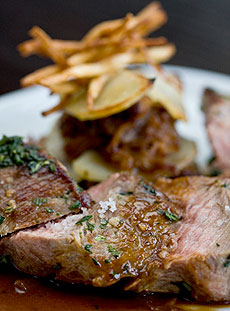Grain-Fed VealVeal is the meat of dairy calves. Dairy cows must give birth to maintain their bodies’ milk supply, so ensuing male calves are used for veal, with the females raised to become milk providers. According to the U.S. Department of Agriculture, the calves are removed from their mothers soon after birth, and are raised until approximately 16 to 18 weeks of age, weighing up to 450 pounds. Veal raised on formula has a white hue due to a lack of iron, while grain- or grass-fed veal has a pinkish hue. In addition, according to a 2007 New York Times article (Veal to Love, Without the Guilt), in a taste test of 20 different cuts of veal, the overwhelming winners were calves that had been raised to between 4 and 6 months of age, and had been fed grain, grass (or both) and milk. However, according to the Veal Quality Assurance Program & Veal Issues Management Program (VealFarm.com), feeding a calf grain or grass causes the calf’s body to undergo the rumination process, giving the meat a more beef-like color, texture and flavor. Calves fed only milk and formula are called “pre-ruminant,” while the veal industry refers to grain-fed calves as “red veal.” Veal has long had a bad reputation, with animal activists decrying formula-fed calves pumped full of antibiotics and hormones, confined for life to dark, cramped stalls in order to get the white meat prized by gourmet chefs. The USDA now has housing and care regulations that ameliorate these issues somewhat, but many calves are still confined to individual stalls inside barns and are largely fed formula. What Is Humanely-Raised Meat?Some farmers and companies, such as Le Québécois, offer a grain-fed, more humane option. There are currently no USDA regulations as to what constitutes “humanely-raised” meat, but Le Québécois adheres to the following criteria:
There are numerous places to find humanely-raised veal in North America. Le Québécois veal can be purchased at MarxFoods.com, or check EatWild.com for local locations and other mail-order purveyors. Now that you’ve got your humanely-raised, environmentally sustainable cuts of meat, let’s get cooking with these delicious recipes! The recipes are ambitious—they were developed by restaurant chefs, after all. But although they have numerous steps, any experienced cook can manage them. And they are very impressive. Continue to Page 2: Herb Roasted Loin of Veal
Recipes courtesy Le Québécois Grain-Fed Veal. Additional material Lifestyle Direct, Inc. All rights reserved. Photos are copyright of their respective owners.
|

